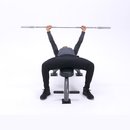The history of Western civilization travels through ancient Egypt, dating back several millennia. Egyptian culture has given us many things, including an affinity for cats. If you're a bodybuilder, even your training program might be influenced by ancient Egyptian construction—that is, if you follow pyramid training.
Pyramid training is one of the most basic and effective training schemes. If you're fuzzy on the details, this article will help you turn any pile of exercises, sets, and reps into your very own muscle-building pyramid plan.
Let's check out the blueprints!
Building A Pyramid
In resistance training, a pyramid is a basic structure that you create when arranging your sets and reps of a given exercise. It entails starting out light and stepping up the weight you use on successive sets. As you keep adding weight, the number of reps you can do goes down, which illustrates the inverse relationship between the two variables.
Pyramid training—also called ascending pyramids—is not terribly complex. Below is an ascending pyramid built on a sample exercise, the barbell bench press.
Sample Bench Press Pyramid
- Set 1: 135 lbs, 15 reps
- Set 2: 185 lbs, 12 reps
- Set 3: 205 lbs, 10 reps
- Set 4: 225 lbs, 8 reps
- Set 5: 245 lbs, 6 reps
- Set 6: 265 lbs, 4 reps
There are a number of advantages to pyramid training for building size and strength, but alas, it's not perfect, so it has spawned a couple of interesting variations. Here's a closer look at some of the pros and cons of following an ascending pyramid.
Pyramid Pros
1. Warm-ups Included
One of the chief advantages of an ascending pyramid is that it includes warm-up sets. You start out light and keep adding weight, which gets the target muscles warm and pliable.
If you've ever gone to the gym and tried to lift a heavy weight without warming up, you know you can't get anywhere near your max weights. You'll be able to lift far more weight and reduce your risk of injury by including a progressive scheme of warm-ups.
"When I first started lifting, I didn't really know what pyramids were, but I was using that exact formula in my training," says Abbie Burrows, IFBB bikini pro and BPI Sports athlete. "I'd always start light to warm up the muscles, and then end up going as heavy as I possibly could (ascending). This system serves to warm up the muscles, reducing the risk of injury, while also prepping the target muscles for the heavier weights to come."
2. Strong to the Core
Ascending pyramids are best suited for those seeking strength gains. Many powerlifters and other athletes seeking absolute max strength don't take nearly as many sets to muscle failure as bodybuilders do—maybe only 1-2 per exercise.
This allows them to generate maximal power on those last 1-2 sets in which they need to move the heaviest weights. All the preceding sets are just warm-ups. The important caveat, however, is that none of those warm-up sets can be taken to muscle failure.
3. Turn up the Volume
Pyramids naturally include a lot of volume. When following an ascending-pyramid scheme and increasing the weight on successive sets, you ultimately do a lot of sets, ensuring that you do a high volume of work—a marker for growth.

Pyramids naturally include a lot of volume.
Multiple-set training systems are superior to really low-volume work for inducing hypertrophy.
Pyramid Cons
That being said, there are two main drawbacks for this kind of training. First, warm-ups should never be done to muscle failure—or anywhere close—but that's a real concern when doing so many sets, especially when you're strong early in your workout.
It's tempting to take a set to muscle failure, but the penalty for doing so is that your strength is slightly compromised on the sets that follow. And if you take several lighter sets to failure, you've just undermined what you're trying to achieve, whether it's building strength or size. You want your muscles to be fresh on your heaviest (last) set; if you've overly fatigued them on the preceding sets, you surely won't be. Hence, those warm-up sets must stop well short of muscle failure.
Second, the above worry may lead you to reach muscle failure on just your last set, which often isn't enough if you're training for maximal muscle size. Reaching muscle failure is important to initiate growth processes. For muscles to grow, they need to undergo a significant amount of stress. One set to failure may not provide the growth stimulus you're looking for.
So while the ascending pyramid works well for someone seeking strength gains, it doesn't work as well for anyone who wants to maximize muscle size. That distinction is important.
Reverse Pyramids
So, if the ascending pyramid isn't necessarily your best choice for building muscle, what is? Enter the descending pyramid, sometimes called reverse-pyramid training. And it's exactly what it sounds like: You start out with your heaviest weights for a few reps, decrease the weight, and do more reps on the sets that follow. It's simply the reverse of the sample pyramid listed above for the bench press.

Reverse-pyramid training is ideal when training for muscle size because you reach muscle failure more often.
Here are a few advantages to using descending pyramids.
1. You Go Heavy First
With a reverse pyramid, you attack your heaviest sets early, when your fatigue levels are low. With fewer sets to burn you out before you tackle your heaviest weights, you recruite the most muscle fibers on that heavy set, which translates into greater growth.
Burrows notes that descending pyramids are better suited for more advanced muscle-building. "I particularly like reverse-pyramid training because you're able to lift the most weight first, before fatigue sets in," she says. "Today, I train in the descending manner with at least four different weights. I'm always the most sore when I train this way."
How Much Weight Do You Use On Back-Off Sets?
When training for muscle growth, your heaviest weight on a multijoint movement should cause muscle failure at around 6-8 reps when done early in your workout. When following a descending-pyramid scheme, take off about 10 percent on successive sets. While the actual weight on those back-off sets will be lighter, it'll still feel heavy because your fatigue levels are somewhat heightened.
2. Hypertrophy Hyperdrive
Reverse-pyramid training is ideal when training for muscle size because you reach muscle failure more often. When training for strength, you don't want to frequently train to muscle failure, but you do when training for size.
With this type of pyramid, you hit failure right off the bat, and you hit it often. Your first set to your last can be done to failure, an important element when it comes to stimulating the kinds of mechanisms responsible for building larger muscles.
"Training to failure is important when building muscle because you're tearing down more muscle fibers," says Burrows. "Training in this way incurs more muscle breakdown."
3. Volume and Intensity
"I try to train this way as often as possible," adds Burrows.

Descending-pyramid training ensures a high volume of work, but it also lets you train with more intensity and weight. When you consider the entire volume of work—sets and reps—of a given movement, you can achieve a greater degree of intensity and stress on the target muscle with a reverse-pyramid approach.
"I try to train this way as often as possible," adds Burrows "It depends how sore I am, but usually I'll take this approach with most upper-body muscle groups, especially shoulders. I love pyramid squats, but it's pretty difficult to walk the rest of the week!"
If you've been paying attention, you'll probably remember that pushing heavy weights requires an extensive warm-up. With a descending pyramid, it's clear there's no warm-up included in the program.
Even though the classic reverse pyramid does not list a warm-up, it would be a big mistake not to do one. And as with ascending pyramids, those warm-ups should never be taken to muscle failure.
After your warm-ups are completed, go right to your working weight, and then follow the reverse-pyramid scheme.
Try On A Triangle
You might think it's cheating to add in warm-up sets but not list them. I can't argue with you. In that case, you can follow what's called the triangle method, which consists of both the ascending and descending aspects of the pyramid.
With triangles, you do a couple of warm-up sets, increasing the weight on each set but not taking those sets to muscle failure. After your heaviest weight, you then follow a descending-pyramid scheme using progressively lighter weights for more reps on the sets that follow, and all those are taken to muscle failure.
This method delivers the volume and intensity critical for building mass. After your first couple of exercises for a given muscle group, you might be able to abandon the warm-ups altogether and go right into a descending pyramid.
For those looking to build muscle, this kind of pyramid is one of the best ways to train.
Pyramid Training Made Easy
Ready to tackle pyramid training, in all of its various forms, in your own lifting program? Check out the quick notes below, and then put them to practice in one of the following sample workouts!
- When following an ascending pyramid, never take warm-up sets to muscle failure. A warm-up set is any set in which you're still going up in weight, which means there's a lower rep target on the following set(s) in the workouts.
- Once you reach your heaviest weight—denoted as the lowest rep target for each exercise—go to muscle failure.
- Bodybuilders and individuals looking to maximize muscle size should take multiple sets to failure, which is why the descending pyramid and triangle method are the most popular.
- Note that the descending pyramid doesn't include warm-up sets; do as many as you need, but never take warm-up sets to muscle failure.

BodyFit
$6.99/month- 2,500+ expert-created single workouts
- 3,500+ how-to exercise videos
- Detailed workout instruction
- Step-by-step workout tips
- Training at gym or at home
- Access to Workout Plans
- Access to Bodyfit App
- Store Discounts
Already have a Bodybuilding.com account with BodyFit? Sign In

What comes with BodyFit?

- Instructional Videos
Don't risk doing a workout improperly! Avoid injury and keep your form in check with in-depth instructional videos.

- How-to Images
View our enormous library of workout photos and see exactly how each exercise should be done before you give it a shot.

- Step-by-Step Instructions
Quickly read through our step-by-step directions to ensure you're doing each workout correctly the first time, every time.




